Why you can trust Tom's Hardware
Comparison Products
We put the T-Create Expert up against the best SSD on the market, including the WD_Black SN850, Samsung 980 Pro, Gigabyte Aorus Gen4 7000s, and Patriot Viper VP4300. We also include some PCIe 3.0 competition, like the WD_Black SN750, Samsung 970 EVO Plus, and Crucial P5.
Game Scene Loading - Final Fantasy XIV
Final Fantasy XIV Shadowbringers is a free real-world game benchmark that easily and accurately compares game load times without the inaccuracy of using a stopwatch.
Scoring fourth place, Team Group’s T-Create Expert tied the Samsung 970 EVO Plus. The Expert surpassed the 980 Pro but couldn’t catch the WD_Black SN850 and Gigabyte Aorus Gen4 7000s.
Transfer Rates – DiskBench
We use the DiskBench storage benchmarking tool to test file transfer performance with a custom dataset. We copy a 50GB dataset including 31,227 files of various types, like pictures, PDFs, and videos to a new folder and then follow-up with a reading test of a newly-written 6.5GB zip file.
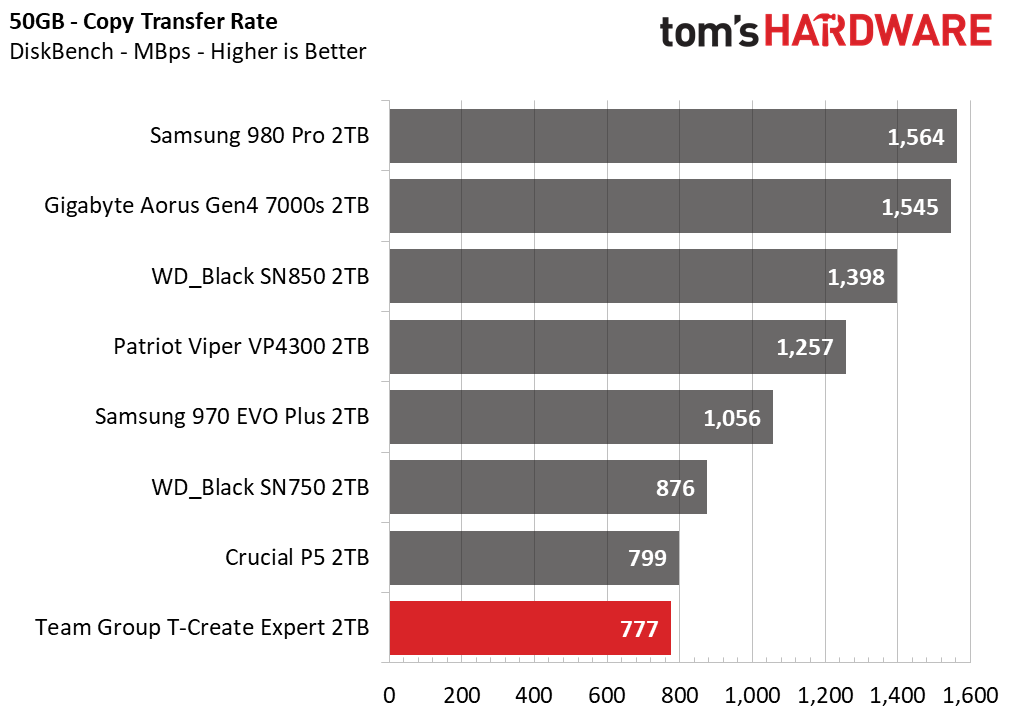

While it delivered responsive game load results, the Team Group T-Create Expert lagged the competition during our file transfer benchmarks. Landing in last place during both the 50GB copy and large file read, the T-Create Expert appears to be more optimized for endurance than responsiveness.
Trace Testing – PCMark 10 Storage Test
PCMark 10 is a trace-based benchmark that uses a wide-ranging set of real-world traces from popular applications and everyday tasks to measure the performance of storage devices. The quick benchmark is more relatable to those who use their PCs for leisure or basic office work, while the full benchmark relates more to power users.


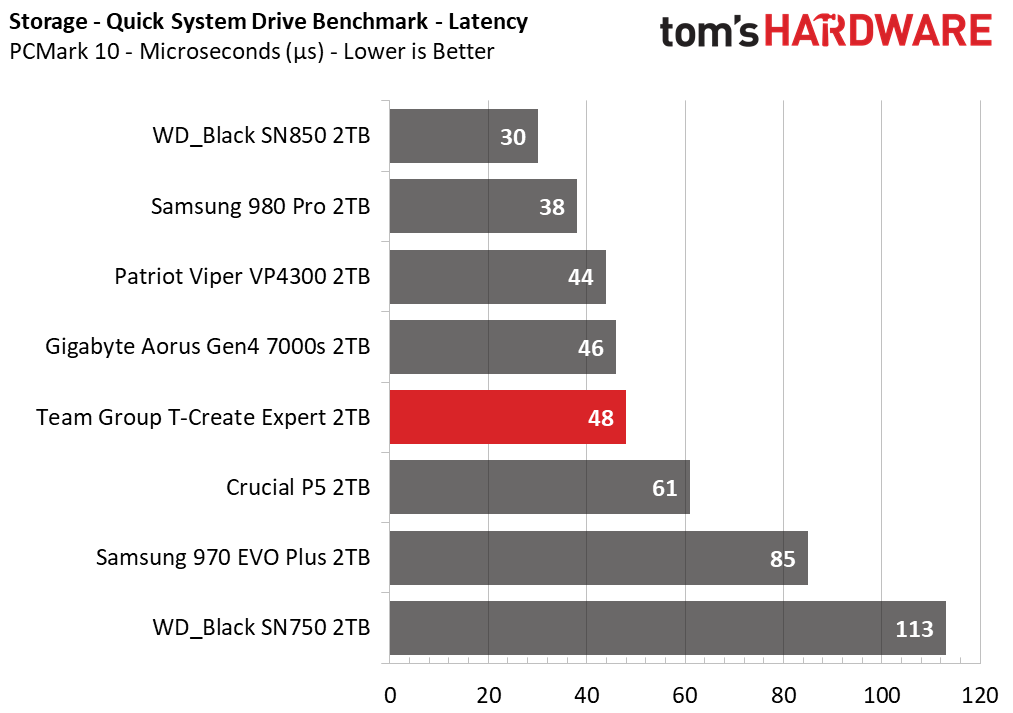
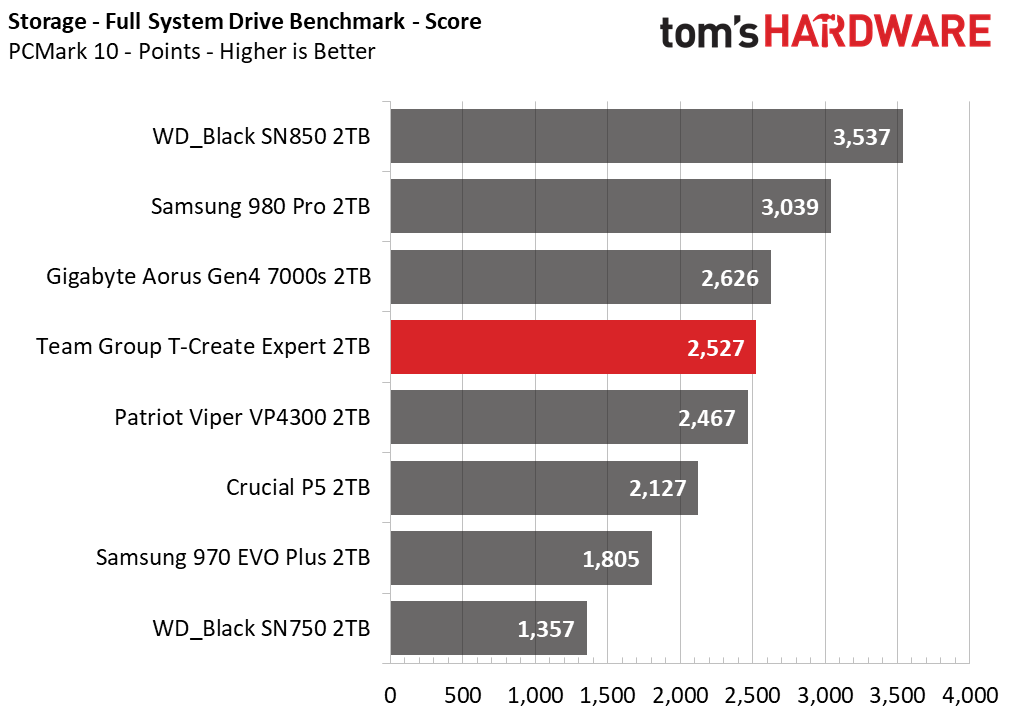


In contrast to the DiskBench results, the Expert delivered respectable results in both of PCMark 10’s workloads. It surpassed the Crucial P5, Samsung 970 EVO Plus, and WD_Black SN750, but ultimately trailed the PCIe 4.0 competitors due to its limited throughput.
Get Tom's Hardware's best news and in-depth reviews, straight to your inbox.
Synthetic Testing - ATTO / CrystalDiskMark
ATTO and CrystalDiskMark (CDM) are free and easy-to-use storage benchmarking tools that SSD vendors commonly use to assign performance specifications to their products. Both of these tools give us insight into how each device handles different file sizes.


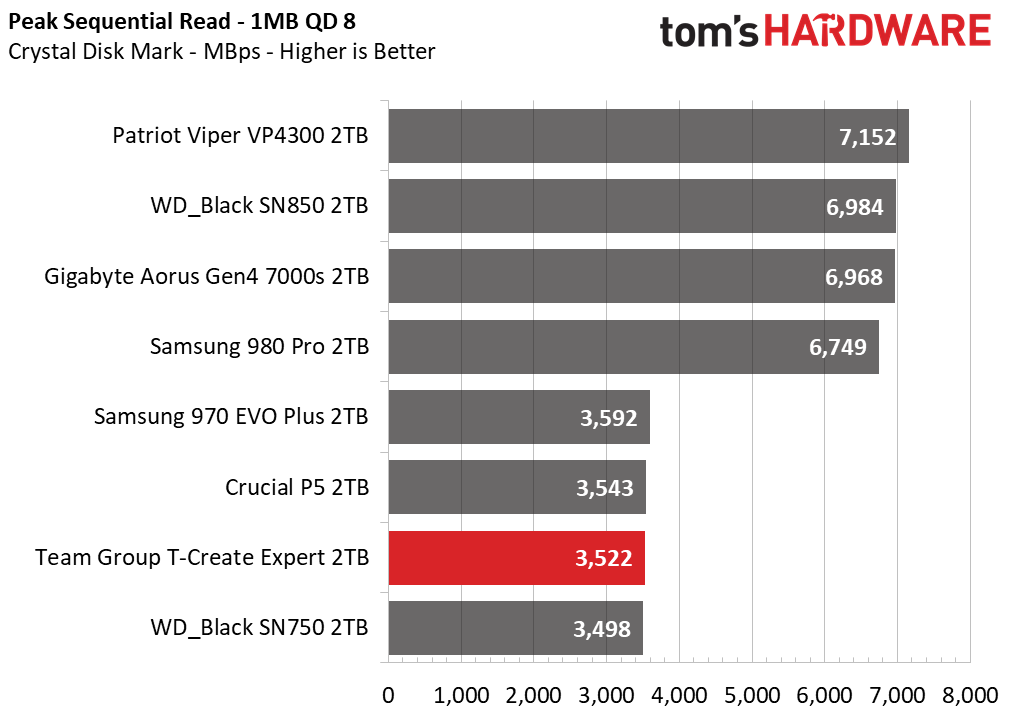








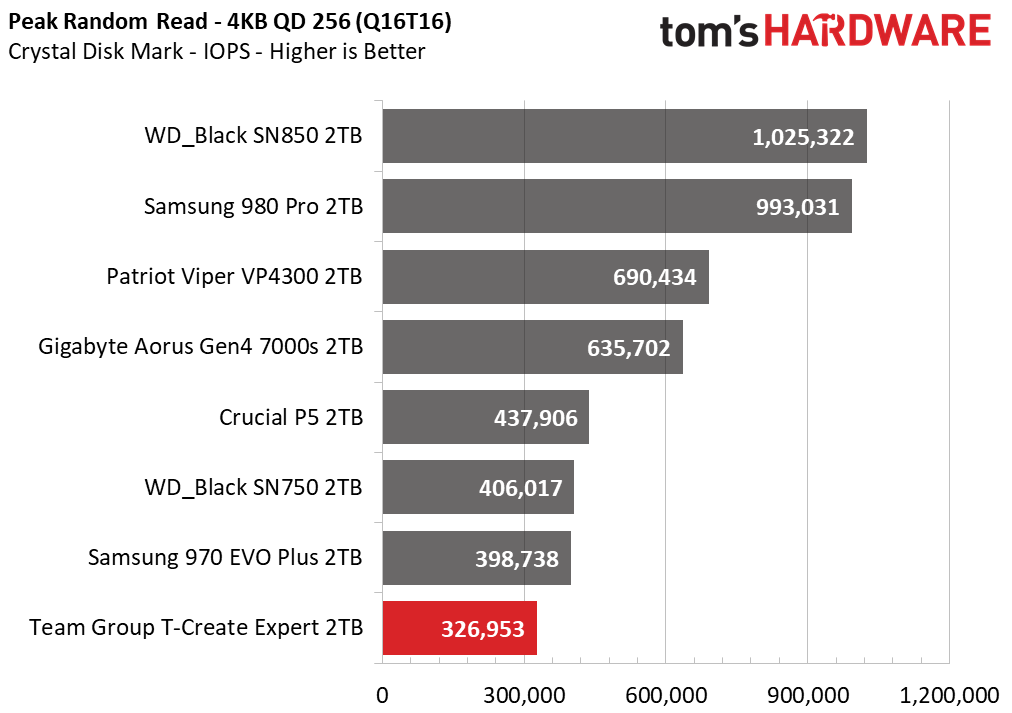


The Expert delivered solid sequential read and write performance across most block sizes at a QD of one (QD1). As a matter of fact, its read performance results were much faster at smaller file sizes than the Crucial P5 and WD_Black SN750. Furthermore, the Expert delivered the fastest random responsiveness out of any PCIe 3.0 competitor, and peak performance exceeded the official spec ratings, too.
However, it couldn't keep up with the likes of the PCIe 4.0 Samsung 980 Pro nor WD_Black SN850. At a QD of 8, throughput measured 3.5/3.2 GBps read/write. Performance in random workloads maxed out at roughly 327,000/374,000 read/write IOPS at a QD of 256.
Sustained Write Performance and Cache Recovery
Official write specifications are only part of the performance picture. Most SSDs implement a write cache, which is a fast area of (usually) pseudo-SLC programmed flash that absorbs incoming data. Sustained write speeds can suffer tremendously once the workload spills outside of the cache and into the "native" TLC or QLC flash. We use iometer to hammer the SSD with sequential writes for 15 minutes to measure both the size of the write cache and performance after the cache is saturated. We also monitor cache recovery via multiple idle rounds.





The T-Create Expert has a large dynamic SLC cache that spans roughly 326GB of our 2TB sample. The Expert wrote at an average rate of 2.8 GBps before it filled the cache. Once filled, the Expert’s write speed degraded to roughly 1,200MBps on average, fluctuating between 950 MBps to 1,450 MBps for the remainder of the test. After idle time, the T-Create Expert recouped roughly 20GB of SLC cache during each of our idle rounds.
Power Consumption and Temperature
We use the Quarch HD Programmable Power Module to gain a deeper understanding of power characteristics. Idle power consumption is an important aspect to consider, especially if you're looking for a laptop upgrade. Some SSDs can consume watts of power at idle while better-suited ones sip just milliwatts. Average workload power consumption and max consumption are two other aspects of power consumption, but performance-per-watt is more important. A drive might consume more power during any given workload, but accomplishing a task faster allows the drive to drop into an idle state more quickly, ultimately saving energy.
We also monitor the drive’s temperature via the S.M.A.R.T. data and an IR thermometer to see when (or if) thermal throttling kicks in and how it impacts performance. Bear in mind that results will vary based on the workload and ambient air temperature.




Power efficiency isn’t the T-Create Expert’s strong suit. Overall, it lands in last place in terms of efficiency. It manages its idle power consumption fairly well, sipping just 741mW at idle with ASPM disabled.
Idle temps measure roughly 40 degrees Celsius, while peak temps hit 77 degrees at the controller after we wrote 450GB of data to the SSD. However, the drive began throttling after we wrote roughly 250GB of data. While active airflow isn’t needed in most cases, it is recommended if you plan to constantly task the T-Create Expert with heavy write or copy workloads like we see during Chia plotting.
Test Bench and Testing Notes
| CPU | Intel Core i9-11900K |
| Motherboard | ASRock Z590 Taichi |
| Memory | 2x8GB Kingston HyperX Predator DDR4 5333 |
| Graphics | Intel UHD Graphics 750 |
| CPU Cooling | Alphacool Eissturm Hurricane Copper 45 3x140mm |
| Case | Streacom BC1 Open Benchtable |
| Power Supply | Corsair SF750 Platinum |
| OS Storage | WD_Black SN850 2TB |
| Operating System | Windows 10 Pro 64-bit 20H2 |
We use a Rocket Lake platform with most background applications such as indexing, windows updates, and anti-virus disabled in the OS to reduce run-to-run variability. Each SSD is prefilled to 50% capacity and tested as a secondary device. Unless noted, we use active cooling for all SSDs.
MORE: Best SSDs
MORE: How We Test HDDs And SSDs
MORE: All SSD Content

Sean is a Contributing Editor at Tom’s Hardware US, covering storage hardware.
-
spongiemaster If someone gave you 100TB of storage for free already filled with chia plots, it would still take over 3 months to break even on the 1TB SSD in the review. Unless it's just disposable income to entertain you, there is no reason to invest any money in Chia farming.Reply -
herrwizo Wait a week or two and it might even become true for 200TB of storage already filled up with plots :)Reply
Complete waste of time for virtually everyone except those who got in within first month and sold everything immediately.
